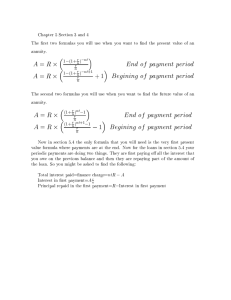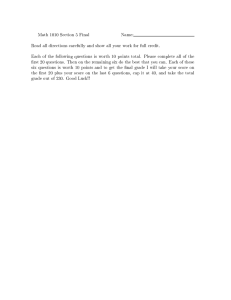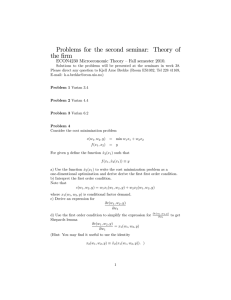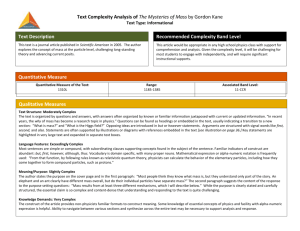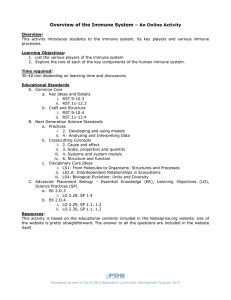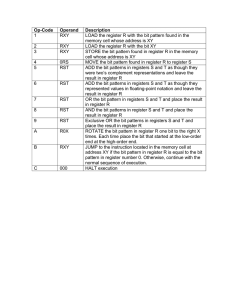RST Analyses from the RST web site ( )
advertisement
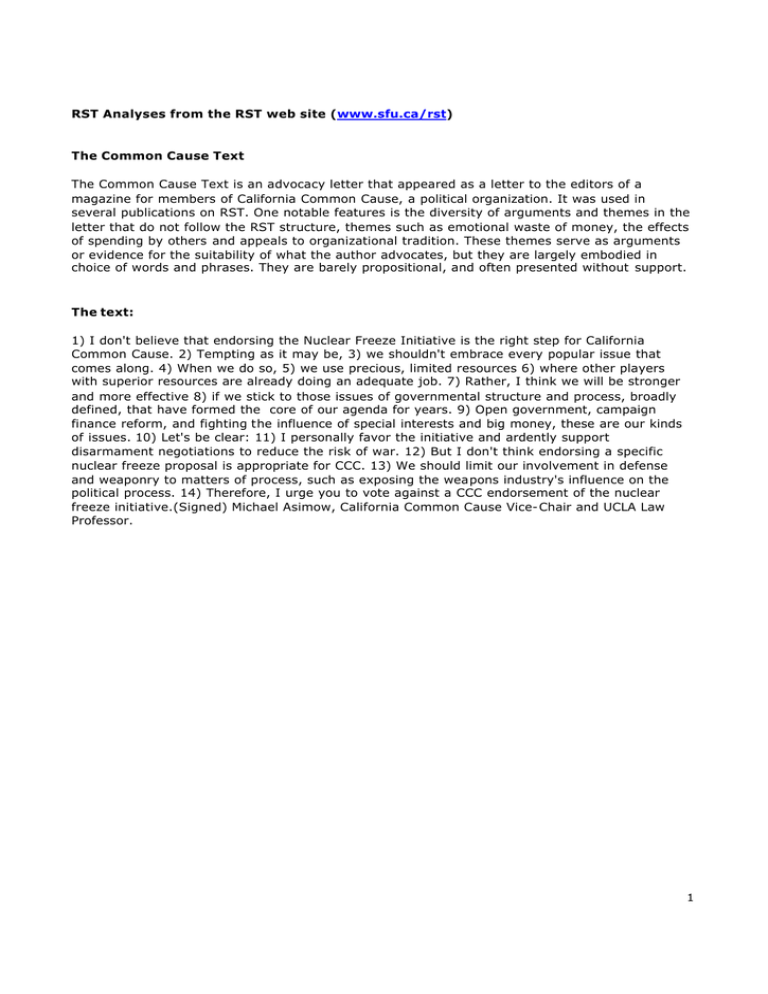
RST Analyses from the RST web site (www.sfu.ca/rst) The Common Cause Text The Common Cause Text is an advocacy letter that appeared as a letter to the editors of a magazine for members of California Common Cause, a political organization. It was used in several publications on RST. One notable features is the diversity of arguments and themes in the letter that do not follow the RST structure, themes such as emotional waste of money, the effects of spending by others and appeals to organizational tradition. These themes serve as arguments or evidence for the suitability of what the author advocates, but they are largely embodied in choice of words and phrases. They are barely propositional, and often presented without support. The text: 1) I don't believe that endorsing the Nuclear Freeze Initiative is the right step for California Common Cause. 2) Tempting as it may be, 3) we shouldn't embrace every popular issue that comes along. 4) When we do so, 5) we use precious, limited resources 6) where other players with superior resources are already doing an adequate job. 7) Rather, I think we will be stronger and more effective 8) if we stick to those issues of governmental structure and process, broadly defined, that have formed the core of our agenda for years. 9) Open government, campaign finance reform, and fighting the influence of special interests and big money, these are our kinds of issues. 10) Let's be clear: 11) I personally favor the initiative and ardently support disarmament negotiations to reduce the risk of war. 12) But I don't think endorsing a specific nuclear freeze proposal is appropriate for CCC. 13) We should limit our involvement in defense and weaponry to matters of process, such as exposing the weapons industry's influence on the political process. 14) Therefore, I urge you to vote against a CCC endorsement of the nuclear freeze initiative.(Signed) Michael Asimow, California Common Cause Vice- Chair and UCLA Law Professor. 1 2 The ZPG Text This is the text that was analyzed by 12 different methods in the Discourse Description: diverse linguistic analyses of a fund raising text book. The text: 1) letterhead. 2) date. 3) salutation 4) At 7:00 a.m. on October 25, our phones started to ring. 5) Calls jammed our switchboard all day. 6A) Staffers stayed late into the night, 6B) answering questions 6C) and talking with reporters from newspapers, radio stations, wire services and TV stations in every part of the country. 7A) When we released the results of ZPG's 1985 Urban Stress Test, 7B) we had no idea we'd get such an overwhelming response. 8) Media and public reaction has been nothing short of incredible! 9) At first, the deluge of calls came mostly from reporters eager to tell the public about Urban Stress Test results and from outraged public officials who were furious that we had "blown the whistle" on conditions in their cities. 10) Now we are hearing from concerned citizens in all parts of the country who want to know what they can do to hold local officials accountable for tackling population- related problems that threaten public health and well- being. 11A) ZPG's 1985 Urban Stress Test, 11B) created after months of persistent and exhaustive research, 11A) is the nation's first survey of how population- linked pressures affect U.S. cities. 12) It ranks 184 urban areas on 11 different criteria ranging from crowding and birth rates to air quality and toxic wastes. 13) The Urban Stress Test translates complex, technical data into an easy-to- use action tool for concerned citizens, elected officials and opinion leaders. 14A) But to use it well, 14B) we urgently need your help. 15A) Our small staff is being swamped with requests for more information 15B) and our modest resources are being stretched to the limit. 16) Your support now is critical. 17) ZPG's 1985 Urban Stress Test may be our best opportunity ever to get the population message heard. 18) With your contribution, ZPG can arm our growing network of local activists with the materials they need to warn community leaders about emerging population- linked stresses before they reach crisis stage. 19A) Even though our national government continues to ignore the consequences of uncontrolled population growth, 19B) we can act to take positive action at the local level. 20) Every day decisions are being made by local officials in our communities that could drastically affect the quality of our lives. 21A). To make sound choices in planning for people, 21B) both elected officials and the American public need the population-stress data revealed by our study. 22) Please make a special contribution to Zero Population Growth today. 23). Whatever you give - $25, $50, $100 or as much as you can -- will be used immediately to put the Urban Stress Test in the hands of those who need it most. 3 The original letter (page 1): 4 The original letter (page 2): 5 6 The Syncom Text The analysis of this advertisment appeared in several publications about RST. It combines orientation to action with orientation to providing informatio n. The text: 1) What if you're having to clean floppy drive heads too often? 2) Ask for SYNCOM diskettes, with burnished Ectype coating and dust- absorbing jacket liners. 3) As you floppy drive writes or reads, 4) a Syncom diskette is working four ways to keep loose particles and dust from causing soft errors, dropouts. 5) Cleaning agents on the burnished surface of the Ectype coating actually remove build- up from the head, 6) while lubricating it at the same time. 7) A carbon additive drains away static electricity 8) before it can attract dust or lint. 9) Strong binders hold the signal-carrying oxides tightly within the coating. 10) And the non- woven jacket liner, 11) more than just wiping the surface, provides thousands of tiny pockets to keep what it collects. 12) To see which Syncom diskette will replace the ones you're using now, 13) send for our free "Flexi- finder" selection guide and the name of the supplier nearest you. 14) [Address, phone number.] Byte Magazine, July 1982 7 The advertisement as it was published: 8 9 The Bouquets Text This is a short newspaper article on the border between exposition and entertainment. The text: 1) Title: Bouquets in a basket - with living flowers 2) There is a gardening revolution going on. 3) People are planting flower baskets with living plants, 4) mixing many types in one container for a full summer of floral beauty. 5) To create your own "Victorian" bouquet of flowers, 6) choose varying shapes, sizes and forms, besides a variety of complementary colors. 7) Plants that grow tall should be surrounded by smaller ones and filled with others that tumble over the side of a hanging basket. 8) Leaf textures and colors will also be important. 9) There is the silver- white foliage of dusty miller, the feathery threads of lotus vine floating down from above, the deep greens, or chartreuse, even the widely varied foliage colors of the coleus. Christian Science Monitor, April, 1983 10 This is the analysis as it appeared in publication: 11 12 The Thumbs Text This text is distinctive in that it has a known, personal addressee. It is an excerpt from a handwritten personal letter from a friend. (The letter goes on to talk about relearning the typewriter.) It is unusual in the way that it raises a small problem as a means of raising a moderate sized problem, leading to the entire excerpt as statement of a large problem. This strategy perhaps indicates something about the personal self representation intended by the writer. The text was included in the published set as part of the effort to establish the breadth of coverage of RST. The text: 1) 2) 3) 4) 5) 6) 7) Thumbs began to be troublesome about 4 months ago and I made an appointment with the best hand surgeon in the Valley to see if my working activities were the problem. Using thumbs is not the problem but heredity is and the end result is no use of thumbs if I don't do something now. 13 14 The Not Laziness Text This is a short newspaper editorial with a political purpose. It illustrates argumentation technique for persuading the reader of something that is, for some readers, controversial and possibly part of conventional wisdom. Although both this text and the "bouquets" text are short expository newspaper articles, analysis shows a sharp difference in their strategies. The text: 1) Farmington police had to help control traffic recently 2) when hundreds of people lined up to be among the first applying for jobs at the yet -to-open Marriott Hotel. 3) The hotel's help-wanted announcement - for 300 openings - was a rare opportunity for many unemployed. 4) The people waiting in line carried a message, a refutation, of claims that the jobless could be employed if only they showed enough moxie. 5) Every rule has exceptions, 6) but the tragic and too-common tableaux of hundreds or even thousands of people snake - lining up for any task with a paycheck illustrates a lack of jobs, 7) not laziness. The Hartford Courant 15 16 The Darwin Text Some titles are preparatory, but this one is the nucleus of the whole text. The text: 1) Darwin as a Geologist 2) He tends to be viewed now as a biologist, 3) but in his five years on the Beagle his main work was geology, 4) and he saw himself as a geologist. 5) His work contributed significantly to the field. 6) Scientific American, Sandra Herbert, May 1986, p. 116. 17 18 The Two Frameworks Text This text is the title and abstract of the article indicated. Like the other abstracts on the website, it is a complete text in the sense that abstracts are in part intended to allow the reader to decide whether to read the article, and for that purpose cannot rely on the unread text of the article. The text was also chosen because it describes the relationship between Systemic Functional Linguistics and RST. We are very interested in developing knowledge of how RST compares with other approaches to discourse analysis. So, we expect to add to the site some analyses or links to alternate analyses of the same or similar texts. Reference: WORD, 42(3), William C. Mann and Christian M. I. M. Matthiessen, December 1991, p. 231-249. The text: 1) Functions of Language in Two Frameworks Abstract 2) Some of the most central problems in linguistics concern how language fills its characteristic roles: how it is useful, the nature and extent of its translatability, and the nature of the integrity of texts. 3) Within linguistics there are many kinds of description that bear on such questions, 4) one kind being the description of language in terms of its functions. 5) Comparing these functional descriptions, 6) the various descriptions do not all cover the same ground. 7) Rather, each is quite partial, 8) and appropriate ways to combine them into a more comprehensive account are not evident. 9) It is hard to know wherein they conflict, wherein they agree, and where they simply speak of different things. 10) This paper is part of an effort to relate various accounts. 11) It is the first in a pair of papers that compare two particular accounts: Rhetorical Structure Theory and Systemic Linguistics. 12) Rhetorical Structure Theory, initially formulated in 1983, describes texts in terms of functionally- defined relations that hold between their parts. 13) Systemic Linguistics is a much more comprehensive view of language initiated in the early 1960s. 14) Where the two approaches are comparable, 15) Systemic Linguistics describes texts in terms of categories of processes which the texts perform. 16) The paper focus on correlating the relations used in rhetorical structure theory with the categories of function found in systemic linguistics. 17) The correlation employs descriptions of speakers' intentions in an essential way. 18) A surprisingly strong correlation results. 19) Ref.: WORD, 42(3), William C. Mann and Christian M. I. M. Matthiessen, December 1991, p. 231-249. 19 20 The British Viewpoint Text This is a little story, intended for amusement. It achieves its effect by building up an image of the circumstances in which one word is spoken. The text: 1) (Overtitle:) True Brit 2) My wife and I are both British, 3) and we enjoy visiting America. 4) We're particularly attracted to the landscape and architecture in Arizona. 5) While looking over a Scottsdale, Ariz., model house one day, 6) my wife was amused by the real-estate agents, 7) who engaged her in the "you talk kinda funny" conversation. 8) We say "tomah-to" and Arizonans say "to- may- to." 9) We call the hood of a car a "bonnet" and the trunk a boot. 10) Then, as my wife entered the dining room, 11) one agent pointed to a massive chandelier and asked, 12) "What would you call that in England?" 13) "Ostentatious," my wife replied. 14) extracted fro m Readers' Digest, September 1999, p. 103, (Overtitle:) True Brit, item 3, quoted from Gary Clark in Arizona Highways. 21 22 The Lactose Text This abstract is nearly half background information. One of the reasons that backgrounding is not signalled by its own distinct signal (such as a conjunction) may be that such a signal would in effect say that the author thought the reader would not know this information. Some readers might find that mildly condescending if it were made explicit. Backgrounding is seldom signalled explicitly. The text: 1) Lactose and Lactase 2) 4) 5) 6) Lactose is milk sugar; 3) the enzyme lactase breaks it down. For want of lactase most adults cannot digest milk. In populations that drink milk the adults have more lactase, perhaps through natural selection. Norman Kretchmer, Scientific American, page 70, October 1972. 23 24 The Mother Teresa Text This is the primary analysis of this text. Two alternate analyses can be reached below. This text is chosen and given three slightly different analyses. This has been done in order to facilitate some thinking about why one analysis might be preferable to another. In this case, preferences seem to revolve around which intentions are most plausible to attribute to the author. Notice that one of the key relationships in the text is an analogical relationship between "Smile at your husbands" and "I find it hard sometimes to smile at Jesus." Notice also that there is no trace of this analogical relationship in the RST analyses of the text. It is certainly a discourse structural element, and it is certainly involved in the way that the text communicates, but it is of a different order than RST identifies. There are inherent limits on how much a monologue oriented method such as RST can find in text containing dialogue. One of the large challenges raised by CRST is to provide some comparable structured whole- text or whole- event representation, first for natural two- party dialogue and eventually for multiparty interaction. The text: 1) Mother Teresa often gives people unexpected advice. 2) When a group of Americans, many in the teaching profession, visited her in Calcutta, 3) they asked her for some advice to take home to their families. 4) "Smile at your wives," she told them. 5) "Smile at your husbands." 6) Thinking that perhaps the counsel was simplistic, 7) coming from an unmarried person, 8) one of them asked, "Are you married?" 9) "Yes," she replied, to their surprise, 10) "and I find it hard sometimes to smile at Jesus. 11) He can be very demanding." 12) Extracted from Reader's Digest, Jan 1986, p. 117 25 Analysis 1: 26 Analysis 2: 27 Analysis 3: 28 The Salvors Text This is one of the largest text analyses on this web site. It is notable for the very elaborate but muted treatment of actions (taken by the highly respected National Geographic Society) which the author does not approve of. It is also notable for the depth of the tree, 16 levels (including the whole text level), and for the elaborate background portion. Is the strategy of using an elaborate background portion related to opposing a respected organization? Since this is a very large text, the analysis is divided into five images. If you print the file, you should be able to see some overlap from one image to the next, and be able to follow the analysis. The text: 1) Archaeological Institute of America 2) fro m the President 3) SCIENCE VS. SALVORS 4) Interest in underwater archaeology is on the rise, 5) while those exploring the seabed are going ever deeper to recover objects from shipwrecks. 6) In the last issue, contributing editor James Wiseman reported on an MIT conference 7) where a small group of scholars and scientists discussed new technologies for deep- sea exploration and recovery of objects. 8) A short time later, I attended a symposium entitled Ancient Mariners, sponsored by the Archaeological Institute of America, AIA's Houston Society, and several other organizations. 9) Aimed at people with an avocational interest in archaeology, 10) the meeting highlighted shipwreck excavations, ancient and historic, from the Gulf of Mexico to the Mediterranean. 11) George Bass, founder of the Institute of Nautical Archaeology (INA) at Texas A&M University, opened the symposium by highlighting the value of scientific excavation of shipwrecks. 12) Our knowledge of ancient shipbuilding techniques, for example, is dependent on the work of archaeologists who have painstakingly excavated remains of ships themselves. 13) The contents of shipwrecks are an equally valuable archaeological resource. 14) Since the objects in a wreck represent a single moment in time, 15) they provide better chronological information than even the most carefully excavated terrestrial site. 16) Moreover, perishable items such as foodstuffs, which do not survive well on land, are often preserved underwater. 17) Today, sport divers and commercial salvors are destroying much of the information that the scientific excavation of shipwrecks can provide. 18) Salvors often sell shares in their operations, 19) promising investors part of the treasure or funds from the sale of artifacts 20) (the fate of t he treasure from Nuestra Senora de Atocha, a Spanish galleon salvaged off the Florida Keys by the late Mel Fisher). 21) In the case of the Whydah, a pirate ship discovered off Wellfleet, Massachusetts, by treasure hunter Barry Clifford, the objects have been kept together, at least for the time being. 22) They are now on view at the National Geographic Society in Washington, D.C., 23) which agreed to display them after other museums refused to do so out of concern that doing so would encourage commercial exploitation of other wrecks. 24) National Geographic has long supported treasure hunters, 25) and in 1996 it sponsored a raffle 26) in which some of the prizes were real pieces- ofeight from the wreck of Nuestra Senora de la Concepcion, a Spanish warship that sank off of Florida in 1641. 27) Bill Allen, editor of National Geographic Magazine, recently suggested that salvors and archaeologists could benefit from working together, 28) but as long as salvors claim 29 ownership to wrecks and sell off their contents, 29) their interests and those of archaeologists will remain at cross purposes. 30) Delegates recently met in Paris to draft a UNESCO convention on Protection of Underwater Cultural Heritage. 31) The U.S. delegation included Jerome Hall, executive director of INA, representing nautical archaeologists, and Gregg Stemm for commercial salvors; 32) five other delegates were from government agencies. 33) Commercial salvors turned out in force, 34) and although the AIA did not participate in the talks, 35) it did submit written comments on the draft convention. 36) Cultural resources, both on land and under water, belong not just to those willing to risk their lives or fortunes for the thrill of exploration or financial gain. 37) They can enrich our knowledge of the past, 38) helping us understand our own and others' cultures. 39) It is important that those of us interested in preserving our cultural heritage make our views known to Congress 40) so that our voice is not drowned out by commercial interests 41) who seek to limit the government's authority to control their activities. 42) (signature) Nancy C. Wilkie, President Archaeological Institute of America 43) Extracted from Archaeology magazine, July/August 1999, p. 8. 30 The text as it appeared: 31 32 33 34 35 36 The Sparky Text This little text is the main body of an advertisment for V8 vegetable juice. It is notable for the extreme feat of imagination that it requires in order to see it as coherent. It is also notable for the lack of cohesive signals, especially that there is no clear signal of cause. The text is addressed to "you." So you must imagine, possibly against personal reality, that: 1. 2. 3. 4. 5. As a child, you had a pet; the pet was named "Sparky;" you threw vegetables under the table (presumably to avoid eating them); Sparky ate them; Eating the vegetables affected Sparky's health. The reader's search for coherence leads to a kind of assertion, in RST terms a Relational Proposition. Cause The notion that the vegetables caused Sparky to live a long time relies on a generalization that eating vegetables tends to cause longevity. It is implicit and defeasible (deniable). It would probably be illegal to make it explicit, because that would be a medical claim, and medical claims are regulated by law. Legal aspects are probably enough of a threat that they are the likely reason for including the fine print disavowal of the claim (see second image.) Preparation The text also illustrates how a background photo can function in a preparatory way, just as the title of a paper does. Without the photo as a leading preparation, the search for coherence might tend to fail. Fiction It is interesting to consider how this sort of text is related to fiction. Certainly, for the advertiser's purposes, the assertion of cause does not belong entirely to the imagined world created by the reader. It must also affect the world in which the reader buys groceries. So, this is more like a parable than it is like a fictional drama. The text: 1) 2) 3) 4) BACKGROUND: PHOTO OF A V8 VEGETABLE JUICE BOTTLE. REMEMBER ALL THOSE VEGETABLES YOU SLIPPED UNDER THE TABLE? MAYBE THAT'S WHY SPARKY LIVED SO LONG. advertisement in Reader's Digest, September 1999, p. 143. 37 The text as it appeared: 38 Here is the fine print: The analysis: 39 The Copyright Text The significance of this text for RST is that it is not really a communicative text, so the structure is filled with the Joint relation, identifying unrelated contributions upward. There is only a very local topical sort of organization. The gross structure is a list of terms. In terms of intentions, the author intended to create and limit rights of use relative to this intellectual property. This has nothing in common with changing the reader, and so is not communicative. This failure to effectively analyze noncommunicative text illustrates that RST has responded to some essential features of communication. The text: ##################################################### # RSTTool LICENSE TERMS This software is copyrighted by the author, Mick O'Donnell. The following terms apply to all files associated with the software unless explicitly disclaimed in individual files. The author hereby grants permission to use, copy, modify, distribute, and license this software and its documentation for any purpose, provided that existing copyright notices are retained in all copies and that this notice is included verbatim in any distributions. No written agreement, license, or royalty fee is required for any of the authorized uses. Modifications to this software may be copyrighted by their authors and need not follow the licensing terms described here, provided that the new terms are clearly indicated on the first page of each file where they apply. IN NO EVENT SHALL THE AUTHOR OR DISTRIBUTORS BE LIABLE TO ANY PARTY FOR DIRECT, INDIRECT, SPECIAL, INCIDENTAL, OR CONSEQUENTIAL DAMAGES ARISING OUT OF THE USE OF THIS SOFTWARE, ITS DOCUMENTATION, OR ANY DERIVATIVES THEREOF, EVEN IF THE AUTHOR HAS BEEN ADVISED OF THE POSSIBILITY OF SUCH DAMAGE. THE AUTHOR AND DISTRIBUTORS SPECIFICALLY DISCLAIM ANY WARRANTIES, INCLUDING, BUT NOT LIMITED TO, THE IMPLIED WARRANTIES OF MERCHANTABILITY, FITNESS FOR A PARTICULAR PURPOSE, AND NON- INFRINGEMENT. THIS SOFTWARE IS PROVIDED ON AN "AS IS" BASIS, AND THE AUTHOR AND DISTRIBUTORS HAVE NO OBLIGATION TO PROVIDE MAINTENANCE, SUPPORT, UPDATES, ENHANCEMENTS, OR MODIFICATIONS. THIS NOTICE MUST NOT BE REMOVED FROM THE SOFTWARE, AND IN THE EVENT THAT THE SOFTWARE IS DIVIDED, IT SHOULD BE ATTACHED TO EVERY PART. ##################################################### 40 41 42 43 The Devotional Reading Text One interest in this devotional page is that it shows an example where effective understanding of the text seems to require recognizing an event in the story which is prominent, but not represented by any text. In the analysis diagram it is represented by "GHOST SEGMENT," along with imputed content. Ellipsed segments of this sort are rare in written mo nologue text. Another interest is that there is an important part of the organization of this text that is carried by a strong template of layout and formatting. Fonts, white space, break lines and positions are employed to give simultaneous approachability to several parts. (The analysis is confined to the body of the right hand page.) RST is implicitly working with a linear view of text and so does not have a representation for these features. The scanned image below shows features of this and the adjacent page. The text: 1) July 27 Tuesday 2) Let Go! 3) Read: Psalm 31:1-8 4) In You, O Lord, I put my trust ... Have mercy on me, O Lord, for I am in trouble. -- Psalm 31:1,9 5) In an article for Campus Life magazine, Susan Smart describes her third - - and nearly last -- solo flight. 6) She had been practicing a maneuver at 5,000 feet 7) when she lost control and her Cessna 150 began spinning wildly toward earth. 8) After several seconds of panic, 9) she recalled her instructor's words: 10) "If you ever go into a spin in a Cessna 150, 11) just let go of the controls. 12) It's built to fly on its own." 13) Susan shouted to herself several times, "Let go!" 14) Finally she yanked her hands from the controls and covered her face. 15) After some wild yawing and pitching, 16) the plane returned to level flight. 17) She had fallen more than half a mile, 18) but she survived 19) because she had the faith to let go. 20) Her experience vividly illustrates what it means to trust God in a time of crisis. 21) I know that 's hard to do 22) when it feels as if everything in our lives is spinning wildly out of control. 23) Our feelings cry out for us to panic, to doubt His promises, to ignore or disobey His instructions, and to try to solve things without Him. 24) But those responses are futile. 25)In Psalm 31, David cried out to the Lord in his time of trouble. 26) He knew that his only hope was to put his situation in God's hands and rely on Him. 27) Is your life in a spin? Let go of the controls! -- DCE 28) Though to your shortsighted vision No way of escape may appear, 29) Trust, for when least you expect it, 30) The help of the Father is near. -- Anon. 31) THE BEST WAY TO HANDLE A PROBLEM IS TO HAND IT OVER TO GOD. 32) Extracted from Our Daily Bread, June July August 1999, RBC Ministries, Grand Rapids, Michigan. 44 The text as it appeared: 45 46 47 48 49 50


